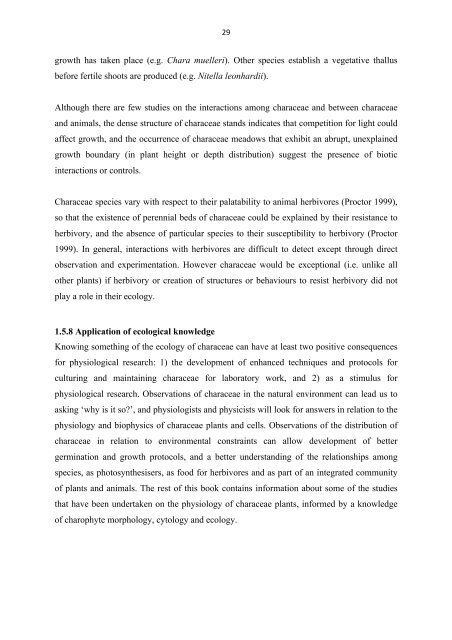Chapter 1: The Characeae Plant
Chapter 1: The Characeae Plant
Chapter 1: The Characeae Plant
Create successful ePaper yourself
Turn your PDF publications into a flip-book with our unique Google optimized e-Paper software.
29 <br />
growth has taken place (e.g. Chara muelleri). Other species establish a vegetative thallus<br />
before fertile shoots are produced (e.g. Nitella leonhardii).<br />
Although there are few studies on the interactions among characeae and between characeae<br />
and animals, the dense structure of characeae stands indicates that competition for light could<br />
affect growth, and the occurrence of characeae meadows that exhibit an abrupt, unexplained<br />
growth boundary (in plant height or depth distribution) suggest the presence of biotic<br />
interactions or controls.<br />
<strong>Characeae</strong> species vary with respect to their palatability to animal herbivores (Proctor 1999),<br />
so that the existence of perennial beds of characeae could be explained by their resistance to<br />
herbivory, and the absence of particular species to their susceptibility to herbivory (Proctor<br />
1999). In general, interactions with herbivores are difficult to detect except through direct<br />
observation and experimentation. However characeae would be exceptional (i.e. unlike all<br />
other plants) if herbivory or creation of structures or behaviours to resist herbivory did not<br />
play a role in their ecology.<br />
1.5.8 Application of ecological knowledge<br />
Knowing something of the ecology of characeae can have at least two positive consequences<br />
for physiological research: 1) the development of enhanced techniques and protocols for<br />
culturing and maintaining characeae for laboratory work, and 2) as a stimulus for<br />
physiological research. Observations of characeae in the natural environment can lead us to<br />
asking ‘why is it so?’, and physiologists and physicists will look for answers in relation to the<br />
physiology and biophysics of characeae plants and cells. Observations of the distribution of<br />
characeae in relation to environmental constraints can allow development of better<br />
germination and growth protocols, and a better understanding of the relationships among<br />
species, as photosynthesisers, as food for herbivores and as part of an integrated community<br />
of plants and animals. <strong>The</strong> rest of this book contains information about some of the studies<br />
that have been undertaken on the physiology of characeae plants, informed by a knowledge<br />
of charophyte morphology, cytology and ecology.
















